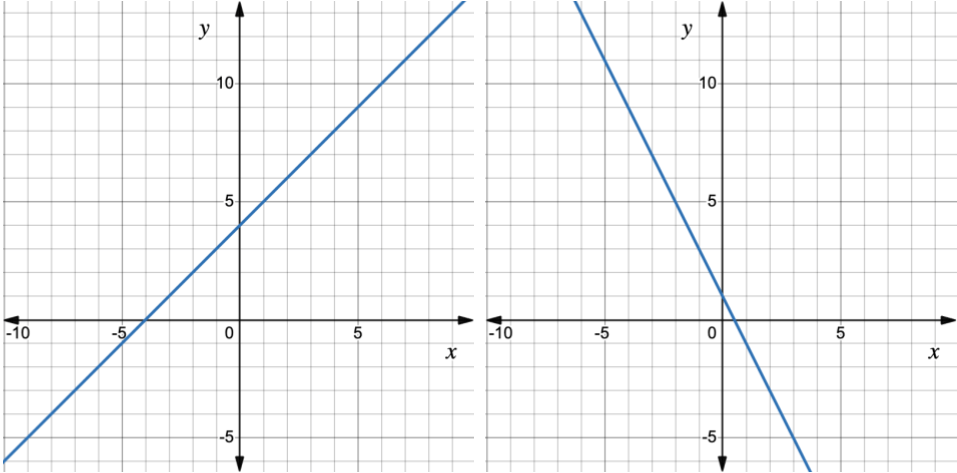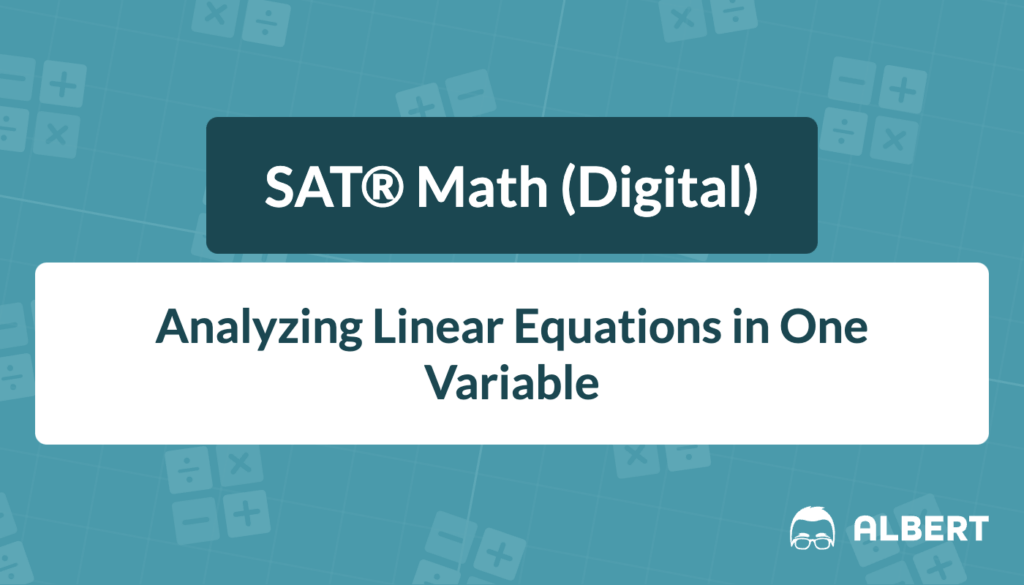What We Review
Introduction
Linear equations are one of the most important topics you’ll learn in algebra. They help describe relationships between numbers and show up in everything from basic word problems to more advanced math and science topics. A linear equation is an equation where the variable is raised to the first power and the graph forms a straight line.
Understanding linear equations builds a foundation for success not only in math class but also in real-world situations, such as budgeting, predicting trends, and problem-solving. In this post, we’ll break down exactly what linear equations are, how to check if a number is a solution, and how to solve different types of linear equations step by step. By the end, you’ll have the tools you need to tackle linear equations with confidence and accuracy!
What is a linear equation?
A linear equation is an equation that involves a variable raised to the first power—no exponents, no square roots, and no variables in the denominator. It’s called “linear” because its solutions form a straight line when graphed. Below are some examples of linear equations.

In this post, we’ll focus on linear equations with one variable–usually written in the form:
ax+b=c
Here’s what each part means:
- x is the variable—the number we’re trying to solve for.
- a, b, and c are constants—fixed numbers.
The equation shows a direct relationship between the variable and the constants.
What makes an equation linear?
An equation is linear if the variable is only raised to the power of \boldsymbol{1}.
✅ These examples are linear:
- 2t + 5 = 9
- \dfrac{1}{3}x - 4 = 2
- -7k = 0
❌ These examples are not linear:
- x^2 + 3 = 10 → quadratic (because of x^2)
- \sqrt{m} + 2 = 5 → contains the square root of a variable
- \dfrac{1}{q} + 4 = 7 → variable is in the denominator
Why do linear equations matter?
Linear equations are one of the first types of equations you learn to solve—and for good reason. They’re the foundation of Algebra. You’ll see them in word problems, Geometry, and even future math classes like Calculus.
Before we learn how to solve them, let’s make sure we know how to check if a number is a solution.
How to determine if a number is a solution to a linear equation
Let’s make sure we understand what a solution is.
A solution is any value that makes the equation true when you substitute it for the variable. To test whether a number is a solution, all you have to do is substitute it into the equation and simplify both sides. If the two sides are equal, it’s a solution!
Checking a value in a two-step linear equation
Is x = 3 a solution to the equation 5x−2=13?
Step 1: Substitute 3 for x.
5(3)−2=13
Step 2: Simplify.
15−2=13
Step 3: Check.
13=13
✓ True!
✅ So yes, x = 3 is a solution.
Evaluating a fraction-based linear equation
Is w = -4 a solution to the equation \dfrac{1}{2}w + 6 = 4?
Step 1: Substitute -4 for w.
\dfrac{1}{2}(-4) + 6 = 4
Step 2: Simplify.
−2+6=4
Step 3: Check.
4=4
✓ True!
✅ Yes, w = -4 is a solution.
Not all numbers work
Is y = 2 a solution to the equation 4(x−1)+3=11?
Step 1: Substitute 2 for y.
4(2−1)+3=11
Step 2: Simplify.
4(1)+3=11
4+3=7
Step 3: Check.
7≠{11}
✗ False!
❌ No, y = 2 is not a solution.
Reminder
To test if a number is a solution:
- Substitute it into the equation.
- Simplify both sides.
- If both sides are equal, ✅ it’s a solution. If not, ❌ it’s not.
How to solve linear equations
Solving a linear equation means finding the value of the variable that makes the equation true. Many linear equations involve more than one step, but if you follow a consistent strategy, they’re completely manageable.
Here’s what to remember:
✅ Start by simplifying both sides of the equation
🔁 Then use inverse operations to isolate the variable
➕/➖ Undo addition or subtraction first
✖️/➗ Then undo multiplication or division
✔️ Always check your solution
Solving a two-step linear equation
Solve 4x−3=21.
| Step | Reason |
| 4x−3=21 | Original equation |
| 4x−3\ \color{red}{+3}\ =21\ \color{red}{+3} | Add 3 to both sides |
| 4x=24 | Simplify |
| \dfrac{4x}{\color{red}{4}} = \dfrac{24}{\color{red}{4}} | Divide both sides by 4 |
| x=6 | Final answer ✅ |
Check:
−3(−3−2)=15\\[1ex] −3(−5)=15\\[1ex] 15=15\\[1ex]✓ True!
Solving a linear equation with a fraction coefficient
Solve \dfrac{1}{2}x + 5 = 9.
| Step | Reason |
| \dfrac{1}{2}x + 5 = 9 | Original equation |
| \dfrac{1}{2}x + 5 \ \color{red}{-5}\ = 9 \ \color{red}{-5} | Subtract 5 from both sides |
| \dfrac{1}{2}x = 4 | Simplify |
| \color{red}{2\ \cdot\ } \dfrac{1}{2}x = 4\color{red}{\ \cdot{\ 2}} | Multiply both sides by 2 |
| x=8 | Final answer ✅ |
Check:
\frac{1}{2}(8) + 5 = 9\\[1ex] 4 + 5 = 9\\[1ex] 9=9\\[1ex]✓ True!
Solving a linear equation with distribution
Solve −3(x−2)+4=19.
| Step | Reason |
| −3(x−2)+4=19 | Original equation |
| −3x+6+4=19 | Distribute the −3 |
| -3x+10=19 | Simplify |
| -3x+10 \ \color{red}{-10}\ =19\ \color{red}{-10} | Subtract 10 |
| -3x=9 | Simplify |
| \dfrac{-3x}{\color{red}{-3}}\ =\dfrac{9}{\color{red}{-3}} | Divide both sides by -3 |
| x=−3 | Final answer ✅ |
Check:
−3(−3−2)=15\\[1ex] −3(−5)=15\\[1ex] 15=15\\[1ex]✓ True!
Solving a linear equation with a variable inside a fraction
Solve \dfrac{2x - 1}{3} = 5.
| Step | Reason |
| \dfrac{2x - 1}{3} = 5 | Original equation |
| \color{red}{3} \ \color{red}{ \cdot}\ \dfrac{2x - 1}{3} = \color{red}{3} \ \color{red}{ \cdot}\ 5 | Multiply both sides by 3 |
| 2x - 1 = 15 | Simplify |
| 2x - 1 \ \color{red}{+1}\ = 15\ \color{red}{+1} | Add 1 to both sides |
| 2x = 16 | Simplify |
| \dfrac{2x}{\color{red}{2}} = \dfrac{16}{\color{red}{2}} | Divide both sides by 2 |
| x=8 | Final answer ✅ |
Check:
\frac{2(8) - 1}{3} =5\\[1ex] \frac{16 - 1}{3} =5 \\[1ex] \frac{15}{3} = 5\\[1ex] 5 = 5\\[1ex]✓ True!
Final tips for solving linear equations
- Always start by simplifying both sides, if necessary.
- Use inverse operations in the correct order: undo addition/subtraction, then multiplication/division.
- Whatever you do to one side, do the same to the other.
- Double-check your solution by substituting it into the original equation.
Conclusion
Linear equations may seem tricky at first, but once you understand how they work, they become one of the most reliable tools in algebra. Whether you’re checking if a number is a solution or solving multi-step equations using inverse operations, the key is to take it one step at a time and stay organized.
As you continue practicing, these steps will start to feel automatic. Keep using what you’ve learned here—substitute carefully, simplify both sides, and always double-check your work. You’ve got the foundation now—let’s build on it!
Need help preparing for your SAT® Math (Digital) exam?
Albert has hundreds of SAT® Math (Digital) practice questions, free response, and full-length practice tests to try out.








